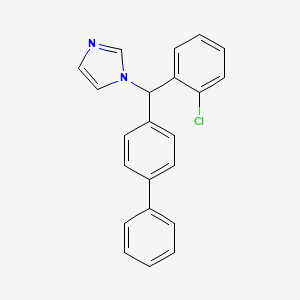
Levofloxacin
Übersicht
Beschreibung
Levofloxacin is a broad-spectrum antibiotic belonging to the fluoroquinolone drug class. It is the optical S-(-) isomer of racemic ofloxacin and is known for its enhanced activity against both gram-negative and gram-positive bacteria . This compound is used to treat a variety of bacterial infections, including respiratory tract infections, urinary tract infections, and skin infections .
Wirkmechanismus
Target of Action
Levofloxacin, a fluoroquinolone antibiotic, primarily targets two key bacterial enzymes: DNA gyrase and topoisomerase IV . These enzymes are crucial for bacterial DNA replication . DNA gyrase introduces negative superhelical twists into DNA, which is important for the initiation of DNA replication . Topoisomerase IV, on the other hand, is involved in the separation of replicated DNA . The primary target of action depends on the type of bacteria. DNA gyrase is the primary fluoroquinolone target for gram-negative bacteria, while topoisomerase IV is the primary target for gram-positive bacteria .
Mode of Action
This compound exerts its antimicrobial activity by inhibiting its primary targets, DNA gyrase and topoisomerase IV . It forms complexes with these enzymes and DNA, blocking the movement of the DNA-replication fork, thereby inhibiting DNA replication . This interaction leads to the cessation of essential cellular processes, resulting in the death of the bacterial cell .
Biochemical Pathways
The inhibition of DNA gyrase and topoisomerase IV disrupts the normal biochemical pathways involved in DNA replication . This disruption prevents the bacteria from multiplying, thereby limiting the spread of the infection . The exact downstream effects of this disruption on other biochemical pathways are complex and involve many genetic and biochemical pathways .
Pharmacokinetics
This compound exhibits excellent bioavailability, with approximately 99% of the orally administered dose being absorbed . It is less than 5% metabolized, with the majority of the drug being excreted unchanged in the urine . The average apparent total body clearance of this compound ranges from 8.64-13.56 L/h, and its renal clearance ranges from 5.76-8.52 L/h . The relative similarity of these ranges indicates a small degree of non-renal clearance .
Result of Action
The inhibition of DNA gyrase and topoisomerase IV by this compound leads to the cessation of DNA replication, resulting in the death of the bacterial cell . This results in the effective treatment of infections caused by susceptible bacteria, including infections of the upper respiratory tract, skin and skin structures, urinary tract, and prostate .
Action Environment
Environmental factors can influence the action, efficacy, and stability of this compound. For instance, the presence of this compound in the aqueous environment can lead to its mitigation or removal via adsorption . Additionally, the presence of residual this compound in the environment can pose an unpredictable threat to the ecosystem . The uptake of this compound can also be seriously hampered (20–60% decrease) by salt competing species in the aqueous phase .
Wissenschaftliche Forschungsanwendungen
Biochemische Analyse
Biochemical Properties
Levofloxacin interacts with bacterial DNA gyrase and topoisomerase IV, which are enzymes essential for bacterial DNA replication, transcription, repair, and recombination . The interaction with these enzymes inhibits the supercoiling activity of bacterial DNA gyrase, halting DNA replication .
Cellular Effects
This compound exerts its effects on various types of cells, particularly bacterial cells. It inhibits bacterial DNA replication, leading to cell death . In human monocytes, this compound enhances the intracellular killing of Staphylococcus aureus and Pseudomonas aeruginosa .
Molecular Mechanism
This compound exerts its effects at the molecular level by binding to the bacterial enzymes DNA gyrase and topoisomerase IV . This binding interaction inhibits the supercoiling activity of these enzymes, thereby halting DNA replication and leading to bacterial cell death .
Temporal Effects in Laboratory Settings
In laboratory settings, this compound exhibits time-dependent killing. Its bactericidal activity increases with longer exposure times, up to a certain point . This compound is stable under normal storage conditions and does not degrade significantly over time .
Dosage Effects in Animal Models
In animal models, the effects of this compound vary with different dosages. Higher dosages lead to greater bacterial killing, but can also result in increased side effects . Toxic or adverse effects at high doses include damage to cartilage and tendons .
Metabolic Pathways
This compound is primarily eliminated unchanged via the kidneys, with less than 5% undergoing metabolic transformation into desmethyl and N-oxide metabolites . It does not significantly interact with or affect other metabolic pathways .
Transport and Distribution
This compound is widely distributed in the body, with an average volume of distribution following oral administration between 1.09-1.26 L/kg . It penetrates well into most body tissues and fluids, with concentrations in many tissues and fluids exceeding those observed in plasma .
Subcellular Localization
This compound does not have a specific subcellular localization as it is not a cellular component or product. It can penetrate bacterial cells and bind to the bacterial enzymes DNA gyrase and topoisomerase IV, which are located in the cytoplasm .
Vorbereitungsmethoden
Synthetic Routes and Reaction Conditions
Levofloxacin can be synthesized through several methods. One common method involves the resolution of racemic ofloxacin using high-pressure liquid chromatography or enzyme resolution . Another method starts with tetrafluorobenzoic acid and involves multiple steps, including cyclization and the addition of N-methylpiperazine . The reaction conditions typically involve maintaining specific temperatures and pH levels to ensure the desired product is obtained .
Industrial Production Methods
Industrial production of this compound often involves optimizing the synthetic routes to increase yield and reduce costs. The process may include the use of solvents and reagents that can be easily recovered and recycled, making the production more efficient and environmentally friendly .
Analyse Chemischer Reaktionen
Types of Reactions
Levofloxacin undergoes various chemical reactions, including:
Oxidation: This compound can be oxidized under certain conditions, leading to the formation of different metabolites.
Reduction: Reduction reactions can alter the functional groups in this compound, affecting its activity.
Substitution: This compound can undergo substitution reactions, particularly with metal ions, forming stable coordination compounds.
Common Reagents and Conditions
Common reagents used in the reactions involving this compound include oxidizing agents, reducing agents, and metal ions such as aluminum, copper, and zinc . The reaction conditions vary depending on the desired outcome but often involve controlled temperatures and pH levels .
Major Products
The major products formed from these reactions include various metabolites and coordination compounds, which can have different pharmacological properties compared to the parent compound .
Vergleich Mit ähnlichen Verbindungen
Levofloxacin is part of the fluoroquinolone class of antibiotics, which includes other compounds such as ciprofloxacin, moxifloxacin, and gemifloxacin . Compared to these compounds, this compound has:
Enhanced Activity: It has a broader spectrum of activity against both gram-positive and gram-negative bacteria.
Better Pharmacokinetics: This compound has a longer half-life and better bioavailability compared to some other fluoroquinolones.
Lower Resistance Rates: It is less prone to resistance development compared to older fluoroquinolones.
List of Similar Compounds
- Ciprofloxacin
- Moxifloxacin
- Gemifloxacin
- Ofloxacin
This compound’s unique properties make it a valuable antibiotic in the treatment of various bacterial infections, and ongoing research continues to explore its full potential in medicine and industry.
Eigenschaften
IUPAC Name |
(2S)-7-fluoro-2-methyl-6-(4-methylpiperazin-1-yl)-10-oxo-4-oxa-1-azatricyclo[7.3.1.05,13]trideca-5(13),6,8,11-tetraene-11-carboxylic acid | |
|---|---|---|
| Source | PubChem | |
| URL | https://pubchem.ncbi.nlm.nih.gov | |
| Description | Data deposited in or computed by PubChem | |
InChI |
InChI=1S/C18H20FN3O4/c1-10-9-26-17-14-11(16(23)12(18(24)25)8-22(10)14)7-13(19)15(17)21-5-3-20(2)4-6-21/h7-8,10H,3-6,9H2,1-2H3,(H,24,25)/t10-/m0/s1 | |
| Source | PubChem | |
| URL | https://pubchem.ncbi.nlm.nih.gov | |
| Description | Data deposited in or computed by PubChem | |
InChI Key |
GSDSWSVVBLHKDQ-JTQLQIEISA-N | |
| Source | PubChem | |
| URL | https://pubchem.ncbi.nlm.nih.gov | |
| Description | Data deposited in or computed by PubChem | |
Canonical SMILES |
CC1COC2=C3N1C=C(C(=O)C3=CC(=C2N4CCN(CC4)C)F)C(=O)O | |
| Source | PubChem | |
| URL | https://pubchem.ncbi.nlm.nih.gov | |
| Description | Data deposited in or computed by PubChem | |
Isomeric SMILES |
C[C@H]1COC2=C3N1C=C(C(=O)C3=CC(=C2N4CCN(CC4)C)F)C(=O)O | |
| Source | PubChem | |
| URL | https://pubchem.ncbi.nlm.nih.gov | |
| Description | Data deposited in or computed by PubChem | |
Molecular Formula |
C18H20FN3O4 | |
| Source | PubChem | |
| URL | https://pubchem.ncbi.nlm.nih.gov | |
| Description | Data deposited in or computed by PubChem | |
DSSTOX Substance ID |
DTXSID0041060 | |
| Record name | Levofloxacin | |
| Source | EPA DSSTox | |
| URL | https://comptox.epa.gov/dashboard/DTXSID0041060 | |
| Description | DSSTox provides a high quality public chemistry resource for supporting improved predictive toxicology. | |
Molecular Weight |
361.4 g/mol | |
| Source | PubChem | |
| URL | https://pubchem.ncbi.nlm.nih.gov | |
| Description | Data deposited in or computed by PubChem | |
Physical Description |
Solid | |
| Record name | Levofloxacin | |
| Source | Human Metabolome Database (HMDB) | |
| URL | http://www.hmdb.ca/metabolites/HMDB0001929 | |
| Description | The Human Metabolome Database (HMDB) is a freely available electronic database containing detailed information about small molecule metabolites found in the human body. | |
| Explanation | HMDB is offered to the public as a freely available resource. Use and re-distribution of the data, in whole or in part, for commercial purposes requires explicit permission of the authors and explicit acknowledgment of the source material (HMDB) and the original publication (see the HMDB citing page). We ask that users who download significant portions of the database cite the HMDB paper in any resulting publications. | |
Solubility |
>54.2 [ug/mL] (The mean of the results at pH 7.4), Sparingly soluble, Freely soluble in glacial acetic acid, chloroform; sparingly soluble in water | |
| Record name | SID49665952 | |
| Source | Burnham Center for Chemical Genomics | |
| URL | https://pubchem.ncbi.nlm.nih.gov/bioassay/1996#section=Data-Table | |
| Description | Aqueous solubility in buffer at pH 7.4 | |
| Record name | Levofloxacin | |
| Source | DrugBank | |
| URL | https://www.drugbank.ca/drugs/DB01137 | |
| Description | The DrugBank database is a unique bioinformatics and cheminformatics resource that combines detailed drug (i.e. chemical, pharmacological and pharmaceutical) data with comprehensive drug target (i.e. sequence, structure, and pathway) information. | |
| Explanation | Creative Common's Attribution-NonCommercial 4.0 International License (http://creativecommons.org/licenses/by-nc/4.0/legalcode) | |
| Record name | Levofloxacin | |
| Source | Hazardous Substances Data Bank (HSDB) | |
| URL | https://pubchem.ncbi.nlm.nih.gov/source/hsdb/8028 | |
| Description | The Hazardous Substances Data Bank (HSDB) is a toxicology database that focuses on the toxicology of potentially hazardous chemicals. It provides information on human exposure, industrial hygiene, emergency handling procedures, environmental fate, regulatory requirements, nanomaterials, and related areas. The information in HSDB has been assessed by a Scientific Review Panel. | |
Mechanism of Action |
Levofloxacin, like other fluoroquinolone antibiotics, exerts its antimicrobial activity via the inhibition of two key bacterial enzymes: DNA gyrase and topoisomerase IV. Both targets are type II topoisomerases, but have unique functions within the bacterial cell. DNA gyrase is an enzyme found only in bacteria that introduces negative supercoils into DNA during replication - this helps to relieve torsional strain caused by the introduction of positive supercoils during replication, and these negative supercoils are essential for chromosome condensation and the promotion of transcription initiation. It is comprised of four subunits (two A subunits and two B subunits) of which the A subunits appear to be the target of fluoroquinolone antibiotics. Bacterial topoisomerase IV, in addition to contributing to the relaxation of positive supercoils, is essential at the terminal stages of DNA replication and functions to “unlink” newly replicated chromosomes to allow for the completion of cell division. Inhibition of these enzymes by levofloxacin likely occurs via complexation with the topoisomerase enzymes. The end result is a blockade of DNA replication, thus inhibiting cell division and resulting in cell death., Levofloxacin is the L-isomer of the racemate, ofloxacin, a quinolone antimicrobial agent. The antibacterial activity of ofloxacin resides primarily in the L-isomer. The mechanism of action of levofloxacin and other fluoroquinolone antimicrobials involves inhibition of bacterial topoisomerase IV and DNA gyrase (both of which are type II topoisomerases), enzymes required for DNA replication, transcription, repair and recombination., Fluoroquinolones prolong the QT interval by blocking voltage-gated potassium channels, especially the rapid component of the delayed rectifier potassium current I(Kr), expressed by HERG (the human ether-a-go-go-related gene). According to the available case reports and clinical studies, moxifloxacin carries the greatest risk of QT prolongation from all available quinolones in clinical practice and it should be used with caution in patients with predisposing factors for Torsades de pointes (TdP). | |
| Record name | Levofloxacin | |
| Source | DrugBank | |
| URL | https://www.drugbank.ca/drugs/DB01137 | |
| Description | The DrugBank database is a unique bioinformatics and cheminformatics resource that combines detailed drug (i.e. chemical, pharmacological and pharmaceutical) data with comprehensive drug target (i.e. sequence, structure, and pathway) information. | |
| Explanation | Creative Common's Attribution-NonCommercial 4.0 International License (http://creativecommons.org/licenses/by-nc/4.0/legalcode) | |
| Record name | Levofloxacin | |
| Source | Hazardous Substances Data Bank (HSDB) | |
| URL | https://pubchem.ncbi.nlm.nih.gov/source/hsdb/8028 | |
| Description | The Hazardous Substances Data Bank (HSDB) is a toxicology database that focuses on the toxicology of potentially hazardous chemicals. It provides information on human exposure, industrial hygiene, emergency handling procedures, environmental fate, regulatory requirements, nanomaterials, and related areas. The information in HSDB has been assessed by a Scientific Review Panel. | |
Color/Form |
Light yellowish -white to yellow-white crystal or crystalline powder, Needles from ethanol + ethyl ether | |
CAS No. |
100986-85-4 | |
| Record name | Levofloxacin | |
| Source | CAS Common Chemistry | |
| URL | https://commonchemistry.cas.org/detail?cas_rn=100986-85-4 | |
| Description | CAS Common Chemistry is an open community resource for accessing chemical information. Nearly 500,000 chemical substances from CAS REGISTRY cover areas of community interest, including common and frequently regulated chemicals, and those relevant to high school and undergraduate chemistry classes. This chemical information, curated by our expert scientists, is provided in alignment with our mission as a division of the American Chemical Society. | |
| Explanation | The data from CAS Common Chemistry is provided under a CC-BY-NC 4.0 license, unless otherwise stated. | |
| Record name | Levofloxacin [USAN:INN:JAN] | |
| Source | ChemIDplus | |
| URL | https://pubchem.ncbi.nlm.nih.gov/substance/?source=chemidplus&sourceid=0100986854 | |
| Description | ChemIDplus is a free, web search system that provides access to the structure and nomenclature authority files used for the identification of chemical substances cited in National Library of Medicine (NLM) databases, including the TOXNET system. | |
| Record name | Levofloxacin | |
| Source | DrugBank | |
| URL | https://www.drugbank.ca/drugs/DB01137 | |
| Description | The DrugBank database is a unique bioinformatics and cheminformatics resource that combines detailed drug (i.e. chemical, pharmacological and pharmaceutical) data with comprehensive drug target (i.e. sequence, structure, and pathway) information. | |
| Explanation | Creative Common's Attribution-NonCommercial 4.0 International License (http://creativecommons.org/licenses/by-nc/4.0/legalcode) | |
| Record name | LEVOFLOXACIN | |
| Source | DTP/NCI | |
| URL | https://dtp.cancer.gov/dtpstandard/servlet/dwindex?searchtype=NSC&outputformat=html&searchlist=758709 | |
| Description | The NCI Development Therapeutics Program (DTP) provides services and resources to the academic and private-sector research communities worldwide to facilitate the discovery and development of new cancer therapeutic agents. | |
| Explanation | Unless otherwise indicated, all text within NCI products is free of copyright and may be reused without our permission. Credit the National Cancer Institute as the source. | |
| Record name | Levofloxacin | |
| Source | EPA DSSTox | |
| URL | https://comptox.epa.gov/dashboard/DTXSID0041060 | |
| Description | DSSTox provides a high quality public chemistry resource for supporting improved predictive toxicology. | |
| Record name | LEVOFLOXACIN ANHYDROUS | |
| Source | FDA Global Substance Registration System (GSRS) | |
| URL | https://gsrs.ncats.nih.gov/ginas/app/beta/substances/RIX4E89Y14 | |
| Description | The FDA Global Substance Registration System (GSRS) enables the efficient and accurate exchange of information on what substances are in regulated products. Instead of relying on names, which vary across regulatory domains, countries, and regions, the GSRS knowledge base makes it possible for substances to be defined by standardized, scientific descriptions. | |
| Explanation | Unless otherwise noted, the contents of the FDA website (www.fda.gov), both text and graphics, are not copyrighted. They are in the public domain and may be republished, reprinted and otherwise used freely by anyone without the need to obtain permission from FDA. Credit to the U.S. Food and Drug Administration as the source is appreciated but not required. | |
| Record name | Levofloxacin | |
| Source | Hazardous Substances Data Bank (HSDB) | |
| URL | https://pubchem.ncbi.nlm.nih.gov/source/hsdb/8028 | |
| Description | The Hazardous Substances Data Bank (HSDB) is a toxicology database that focuses on the toxicology of potentially hazardous chemicals. It provides information on human exposure, industrial hygiene, emergency handling procedures, environmental fate, regulatory requirements, nanomaterials, and related areas. The information in HSDB has been assessed by a Scientific Review Panel. | |
| Record name | Levofloxacin | |
| Source | Human Metabolome Database (HMDB) | |
| URL | http://www.hmdb.ca/metabolites/HMDB0001929 | |
| Description | The Human Metabolome Database (HMDB) is a freely available electronic database containing detailed information about small molecule metabolites found in the human body. | |
| Explanation | HMDB is offered to the public as a freely available resource. Use and re-distribution of the data, in whole or in part, for commercial purposes requires explicit permission of the authors and explicit acknowledgment of the source material (HMDB) and the original publication (see the HMDB citing page). We ask that users who download significant portions of the database cite the HMDB paper in any resulting publications. | |
Melting Point |
225-227C, 225-227 °C (decomposes) | |
| Record name | Levofloxacin | |
| Source | DrugBank | |
| URL | https://www.drugbank.ca/drugs/DB01137 | |
| Description | The DrugBank database is a unique bioinformatics and cheminformatics resource that combines detailed drug (i.e. chemical, pharmacological and pharmaceutical) data with comprehensive drug target (i.e. sequence, structure, and pathway) information. | |
| Explanation | Creative Common's Attribution-NonCommercial 4.0 International License (http://creativecommons.org/licenses/by-nc/4.0/legalcode) | |
| Record name | Levofloxacin | |
| Source | Hazardous Substances Data Bank (HSDB) | |
| URL | https://pubchem.ncbi.nlm.nih.gov/source/hsdb/8028 | |
| Description | The Hazardous Substances Data Bank (HSDB) is a toxicology database that focuses on the toxicology of potentially hazardous chemicals. It provides information on human exposure, industrial hygiene, emergency handling procedures, environmental fate, regulatory requirements, nanomaterials, and related areas. The information in HSDB has been assessed by a Scientific Review Panel. | |
Retrosynthesis Analysis
AI-Powered Synthesis Planning: Our tool employs the Template_relevance Pistachio, Template_relevance Bkms_metabolic, Template_relevance Pistachio_ringbreaker, Template_relevance Reaxys, Template_relevance Reaxys_biocatalysis model, leveraging a vast database of chemical reactions to predict feasible synthetic routes.
One-Step Synthesis Focus: Specifically designed for one-step synthesis, it provides concise and direct routes for your target compounds, streamlining the synthesis process.
Accurate Predictions: Utilizing the extensive PISTACHIO, BKMS_METABOLIC, PISTACHIO_RINGBREAKER, REAXYS, REAXYS_BIOCATALYSIS database, our tool offers high-accuracy predictions, reflecting the latest in chemical research and data.
Strategy Settings
| Precursor scoring | Relevance Heuristic |
|---|---|
| Min. plausibility | 0.01 |
| Model | Template_relevance |
| Template Set | Pistachio/Bkms_metabolic/Pistachio_ringbreaker/Reaxys/Reaxys_biocatalysis |
| Top-N result to add to graph | 6 |
Feasible Synthetic Routes
Haftungsausschluss und Informationen zu In-Vitro-Forschungsprodukten
Bitte beachten Sie, dass alle Artikel und Produktinformationen, die auf BenchChem präsentiert werden, ausschließlich zu Informationszwecken bestimmt sind. Die auf BenchChem zum Kauf angebotenen Produkte sind speziell für In-vitro-Studien konzipiert, die außerhalb lebender Organismen durchgeführt werden. In-vitro-Studien, abgeleitet von dem lateinischen Begriff "in Glas", beinhalten Experimente, die in kontrollierten Laborumgebungen unter Verwendung von Zellen oder Geweben durchgeführt werden. Es ist wichtig zu beachten, dass diese Produkte nicht als Arzneimittel oder Medikamente eingestuft sind und keine Zulassung der FDA für die Vorbeugung, Behandlung oder Heilung von medizinischen Zuständen, Beschwerden oder Krankheiten erhalten haben. Wir müssen betonen, dass jede Form der körperlichen Einführung dieser Produkte in Menschen oder Tiere gesetzlich strikt untersagt ist. Es ist unerlässlich, sich an diese Richtlinien zu halten, um die Einhaltung rechtlicher und ethischer Standards in Forschung und Experiment zu gewährleisten.


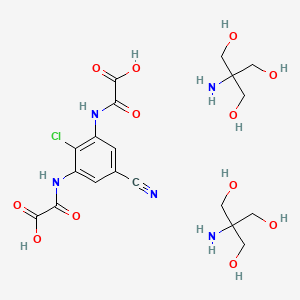
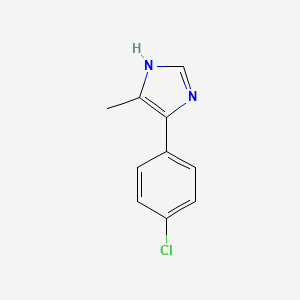
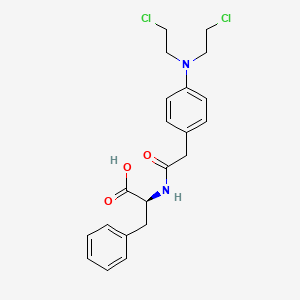
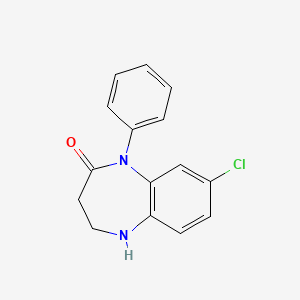
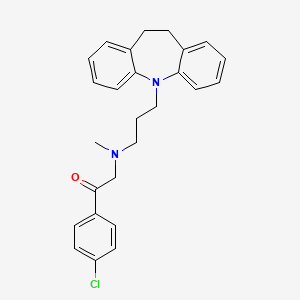
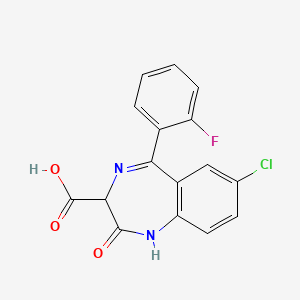
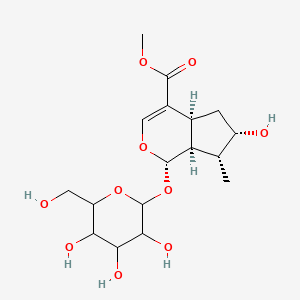
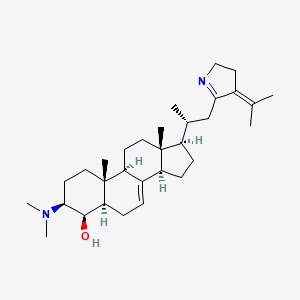
![N-[(3S,4R,5S,9R,10R,13R,14R,17R)-4-hydroxy-10,13-dimethyl-17-[(2R)-1-(4-propan-2-ylidene-2,3-dihydropyrrol-5-yl)propan-2-yl]-2,3,4,5,6,9,11,12,14,15,16,17-dodecahydro-1H-cyclopenta[a]phenanthren-3-yl]acetamide](/img/structure/B1675032.png)
![(1S,9R,13R,19S,22S,23S,25R,26R,28S,31S,33S,36R)-22-Hydroxy-1,10,10,12,12,30,30,36-octamethyl-28-(2-methylprop-1-enyl)-11,24,27,29,32-pentaoxa-3-azadecacyclo[17.17.0.02,17.04,16.07,15.09,13.022,36.023,25.023,33.026,31]hexatriaconta-2(17),4(16),5,7(15)-tetraen-8-one](/img/structure/B1675035.png)
![2-[(3R,6S,9S,12S,15S,18S,21S,24R,27S,30S)-21-(2-amino-2-oxoethyl)-9-(3-aminopropyl)-24,27-dibenzyl-3-[(4-hydroxyphenyl)methyl]-15-(1H-indol-3-ylmethyl)-6-(2-methylpropyl)-2,5,8,11,14,17,20,23,26,29-decaoxo-12-propyl-1,4,7,10,13,16,19,22,25,28-decazabicyclo[28.3.0]tritriacontan-18-yl]acetic acid](/img/structure/B1675036.png)
